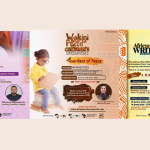About the Poet: Also known as Mom’s Moana, Gisele Ingabire is a tough woman with a heart of gold. I wouldn’t want to meet her on opposing sides in court, but I always love to read her pieces. As one who has declared to ‘love love,’ she has yet to disappoint with her ability to show not just the beauty of love but also its painful side. Her poem A Tale of Tears and Tender Touch portrays the pain of desire mistaken for love that an innocent being experiences and the empathetic love of a mother that comforts them in the end.
Themes: The poet makes use of the themes of desire, pain, empathy, and love in the piece’s portrayal. Why desire? Desire is the emotion the fairy displays, not love, as one can notice in the third stanza (S3). The word ‘enthralled’ in S3’s third line could just be used to describe the World Rose’s beauty capturing the fairy’s attention. Still, as the next line states, upon that first sight, “The fairy wished for its petals,” which is not love, but rather a sort of childlike desire – untempered by knowledge and cautiousness of having experienced the world.
Pain is the most prevalent theme throughout the piece, mentioned first in stanza two, line three (S2 L3). “Her heart bled with joy and sorrow,” where the character referred to as ‘Her’, has her heart bleed. “With joy and sorrow” at the thought of what awaited the fairy ahead. Pain is again mentioned in S4L3 as “his fingers pricked” by the World’s Rose and ended up quivering. Finally, S5L4 mentions soothing the wounds of the fairy in her arms.
Empathy can be spotted throughout the piece, like in S2 L4 where ‘Her’ heart bleeds with joy and sorrow. “For she knew trials laid down the road of this fragile being.” In this line, the character is portrayed as one who has experienced or has knowledge of what the fairy has yet to experience, but will surely do soon.
Love: A Tale of Tears and Tender Touch has a sort of paradoxical nature where it seems absurd that ‘Her’, despite her love for the fairy does nothing but stand by as she watches it unfold. ‘Her’ is present at all times, even before the fairy is stirred or perhaps born. She is watching as the fairy opens its eyes and is, “Enthralled by the World Rose’s beauty fair.” Perhaps had she stepped in, she could have prevented the obvious consequential pain, but she did not.
Is this not what a mother’s love is truly like? Let me elaborate further; love is oftentimes seen as an overprotective force that can shield the recipient from all harm. It is viewed as a shower of love and praise, but a mother’s love, as the piece shows us, is more than that. A mother’s love embraces a balance of protection and the freedom to learn from one’s own experience and in Mom’s Moana’s piece, ‘Her’ lets the fairy experience it for herself. It’s a painful sort of love.
Poetic Devices:
Visual Imagery
The visual imagery employed gives the piece a soft setting, ‘a night in early spring.’ with a tinge of foreboding that blows in with the ‘soft breaths of wind,| … cool enough to make her shiver’ and as the night turns into ‘the soft glow of dawn’s light ‘Her’s heart bled with joy and sorrow. The poet captures a reader’s mind with the stark contrast between dawn’s soft glow and Her’s bleeding heart. Mom’s Moana’s description of the tiny being’s, “wings like gossamer threads” makes the reader imagine the beauty and fragility of the newly-born creature. This makes the reader further relate to the character ‘Her.’
Metaphor and Simile:
Metaphors and similes are also used in S2 L3 and S4 L4 respectively. “Her heart bled with joy and sorrow,” metaphor is used to emphasise Her’s overwhelming emotions as her heart bleeds with said emotions. “The fairy’s orbs as blue as forget-me-nots spilled the first sorrowful tears.” This simile is used to describe the fairy’s intensely blue eyes. Forget-me-nots can be a “pledge that you will never forget them and that you will think of them often” and mention of this, serves as a symbol that the fairy, despite the pain, will not forget the experience, the emotion and most importantly, the World’s Rose.
Personification:
Wind in the first stanza is personified by doing human activities as seen in S1 L2. “With the first soft breaths of wind.” This tale of tears from a beautiful rose’s thorns ends with comforting touch of a mother, whose love soothes and heals the pain the world leaves on the skin.



